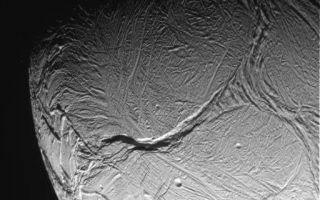
PIA11121: Enceladus Oct. 9, 2008 Flyby - Posted Image #3
|
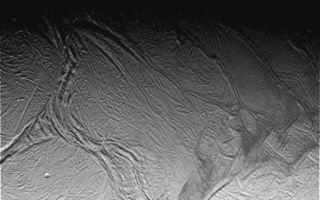
PIA11122: Enceladus Oct. 9, 2008 Flyby - Posted Image #4
|
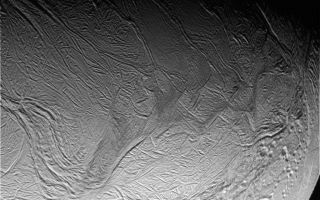
PIA11123: Enceladus Oct. 9, 2008 Flyby - Posted Image #5
|
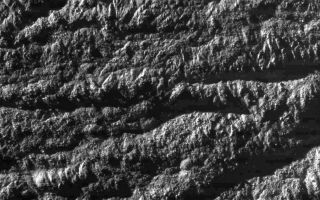
PIA11124: Enceladus Rev 91 Flyby - Skeet Shoot #1
|
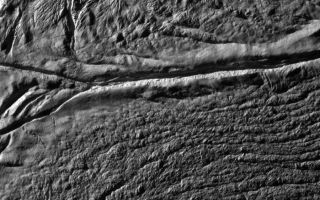
PIA11125: Enceladus Rev 91 Flyby - Skeet Shoot #8
|
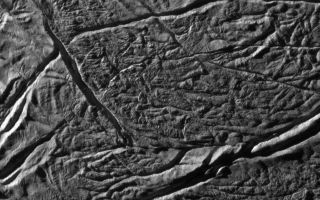
PIA11127: Enceladus Rev 91 Flyby - Skeet Shoot #9
|
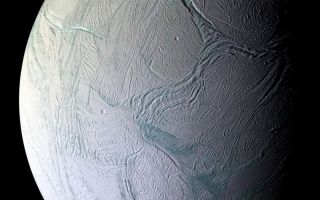
PIA11133: A Tectonic Feast
|
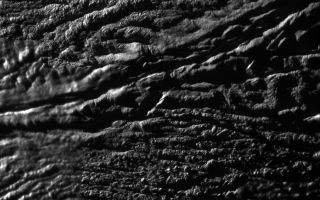
PIA11134: Enceladus Rev 91 Flyby - Skeet Shoot 1-4 Mosaic
|
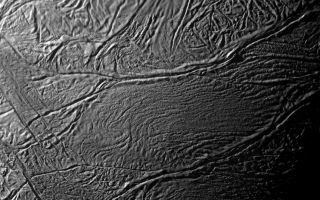
PIA11135: Tiger Stripes...Magnified!
|
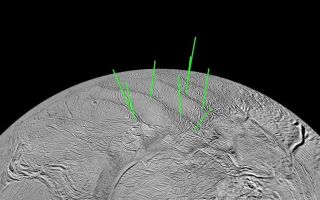
PIA11136: Enceladus' Jets
|
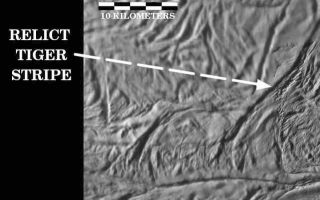
PIA11137: Reconstructing the Past on Enceladus
|
![<h1>PIA11138: Spreading Ridge Transforms On Enceladus</h1><div class="PIA11138" lang="en" style="width:800px;text-align:left;margin:auto;background-color:#000;padding:10px;max-height:150px;overflow:auto;"><p>These two side-by-side images compare a characteristic sea-floor spreading feature on Earth, known as a spreading ridge transform, to a very similar looking arrangement of "tiger stripe" rift segments in the south polar terrain region of Saturn's moon Enceladus. </p><p>The left image shows a shaded relief map of bathymetry (or sonar-like topography) data covering a fast-spreading ridge along the Earth's East Pacific Rise at 9.5 degrees north latitude, 104 degrees west longitude. Spreading ridges are laterally offset in a characteristic "zig-zag" pattern that closely matches the offset pattern seen on the Enceladus tiger stripe rifts. Striations parallel to the seafloor ridges are produced symmetrically when upwelling magma in the rifts solidify and become welded on each side of the central trench. </p><p>In contrast, the transform-like structure on Enceladus (in the image on the right) is flanked by a very complicated arrangement of old fractures. If the Enceladus feature is indeed a type of transform, it indicates spreading in a way that significantly differs from sea-floor spreading: Either the Enceladus feature is not spreading symmetrically from the center of the tiger stripe rifts as usually occurs in terrestrial sea-floor spreading centers, or else the original indicators of symmetrical spreading have been erased by a complicated superposed fracture history. </p><p>The Enceladus data were acquired by NASA's Cassini spacecraft's imaging science sub-system during four close-targeted flybys of Enceladus in March, August and October 2008. </p><p>The Cassini-Huygens mission is a cooperative project of NASA, the European Space Agency and the Italian Space Agency. The Jet Propulsion Laboratory, a division of the California Institute of Technology in Pasadena, manages the mission for NASA's Science Mission Directorate, Washington, D.C. The Cassini orbiter and its two onboard cameras were designed, developed and assembled at JPL. The imaging operations center is based at the Space Science Institute in Boulder, Colo.</p><p>For more information about the Cassini-Huygens mission visit <a href="http://saturn.jpl.nasa.gov" class="external free" target="wpext">http://saturn.jpl.nasa.gov/</a>. The Cassini imaging team homepage is at <a href="http://ciclops.org" class="external free" target="wpext">http://ciclops.org</a>.</p><p>Sea-floor bathymetry data ©2008 MGDS; www.marine-geo.org from Carbotte, S.M., R. Arko, D.N. Chayes, W. Haxby, K. Lehnert, S. O'Hara, W.B.F. Ryan, R.A. Weissel, T. Shipley, L. Gahagan, K. Johnson, T. Shank (2004), New Integrated Data Management System for Ridge2000 and MARGINS Research, Eos Trans. AGU, 85(51), 553, DOI: 10.1029/2004EO510002.]<br /><br /><a href="http://photojournal.jpl.nasa.gov/catalog/PIA11138" onclick="window.open(this.href); return false;" title="Voir l'image PIA11138: Spreading Ridge Transforms On Enceladus sur le site de la NASA">Voir l'image PIA11138: Spreading Ridge Transforms On Enceladus sur le site de la NASA.</a></div>](system/html/PIA11138-272804f8.jpg)
PIA11138: Spreading Ridge Transforms On Enceladus
|
![<h1>PIA11139: Enceladus Offset Spreading Center</h1><div class="PIA11139" lang="en" style="width:800px;text-align:left;margin:auto;background-color:#000;padding:10px;max-height:150px;overflow:auto;"><p>These two side-by-side images compare a "twisted" sea-floor spreading feature on Earth, known as an Offset Spreading Center (OSC), to a very similar looking twisted break, or axial discontinuity, in the Damascus Sulcus "tiger stripe" on Saturn's moon Enceladus. The image of Enceladus was acquired by NASA's Cassini spacecraft imaging science sub-system during one of its four close targeted flybys of Enceladus in March, August and October 2008. </p><p>The image on the left shows a shaded relief map of bathymetry (or sonar-like topography) data along a spreading ridge on the East Pacific Rise near 9.5 degrees north latitude and 104 minutes west longitude. On Earth, OSC's occur only along fast-spreading ridges—ones that spread faster than about 100 millimeters (4 inches) per year. They do not occur on slow-spreading ridges, like the famous Mid-Atlantic Ridge where spreading rates are often less than 20 millimeters (0.7 inches) per year. </p><p>The axial discontinuity on Enceladus' Damascus Sulcus, shown in the image on the right, twists in the same helical way that the OSC does on Earth. However, the morphological resemblance is no guarantee that both features are caused by fast spreading. </p><p>On Earth OSCs form when two nearly parallel spreading ridges lengthen along their ridge (or long) axes. As the lengthening tips of the ridges pass each other side-by-side in opposite directions, shear forces caused by tectonic spreading between them force the two tips to twist around each other. The twisting tip of each one eventually merges with the "neck" of the other in a "yin-yang" shaped pattern. The result is an oval shaped basin that is surrounded by the twisted ridge tips. </p><p>On Enceladus, the twisted features have not produced an oval basin, but the pattern of the twist is very similar to the terrestrial OSC and probably similar tectonic shear forces, perhaps even tectonic spreading, resulted in this twisted shape. Note that the Enceladus image has been flipped right-to-left to make comparison to the sea-floor feature easier to see. </p><p>The Cassini-Huygens mission is a cooperative project of NASA, the European Space Agency and the Italian Space Agency. The Jet Propulsion Laboratory, a division of the California Institute of Technology in Pasadena, manages the mission for NASA's Science Mission Directorate, Washington, D.C. The Cassini orbiter and its two onboard cameras were designed, developed and assembled at JPL. The imaging operations center is based at the Space Science Institute in Boulder, Colo.</p><p>For more information about the Cassini-Huygens mission visit <a href="http://saturn.jpl.nasa.gov" class="external free" target="wpext">http://saturn.jpl.nasa.gov/</a>. The Cassini imaging team homepage is at <a href="http://ciclops.org" class="external free" target="wpext">http://ciclops.org</a>.</p><p>Sea-floor bathymetry data ©2008 MGDS; www.marine-geo.org from Carbotte, S.M., R. Arko, D.N. Chayes, W. Haxby, K. Lehnert, S. O'Hara, W.B.F. Ryan, R.A. Weissel, T. Shipley, L. Gahagan, K. Johnson, T. Shank (2004), New Integrated Data Management System for Ridge2000 and MARGINS Research, Eos Trans. AGU, 85(51), 553, DOI: 10.1029/2004EO510002.]<br /><br /><a href="http://photojournal.jpl.nasa.gov/catalog/PIA11139" onclick="window.open(this.href); return false;" title="Voir l'image PIA11139: Enceladus Offset Spreading Center sur le site de la NASA">Voir l'image PIA11139: Enceladus Offset Spreading Center sur le site de la NASA.</a></div>](system/html/PIA11139-cc292ae6.jpg)
PIA11139: Enceladus Offset Spreading Center
|
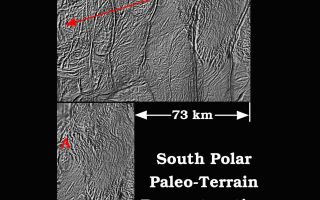
PIA11140: Ancient Terrain on Enceladus
|
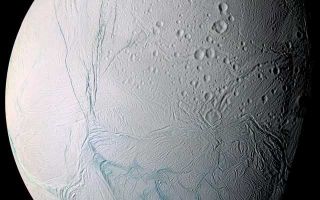
Saturne_Encelade_5.jpg
|
|